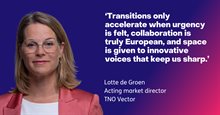Using network analysis of patent citations, we reveal where our country is strong, where vulnerabilities lie, and how international dependencies are evolving. In doing so, we provide policymakers and businesses with concrete insights to make strategic choices for the future.
In this article, we describe the new analytical method, show how the Netherlands performs within global knowledge networks, and offer guidance for innovation policy aimed at strengthening technological sovereignty.
Growing importance of technology positioning in a geopolitical context
Recent disruptions, such as the growing rivalry between the United States and China, have exposed the vulnerability of European economies to international dependencies. Competition for critical technologies, raw materials and knowledge is increasing, while international cooperation is under pressure.
Within this context, the concept of technological sovereignty is gaining weight. It refers to a country’s ability to independently develop crucial technologies that determine national prosperity and security. This does not mean countries should isolate themselves: technological sovereignty can in fact be strengthened through reliable international cooperation. Only when access to crucial knowledge or technology is under threat, is there a lack of sovereignty.
The pursuit of technological sovereignty fits within the broader European ambition of open strategic autonomy: the ability to pursue independent policy, while maintaining cooperation and openness. Both concepts emphasise strengthening national freedom of action in a world of mutual dependencies, with technological sovereignty focusing on the role of critical technologies.
Technological sovereignty in policy perspective
Global competition for key technologies is fierce. Countries are developing new strategies to protect their technological position. The Netherlands has also taken steps in this area. The Ministry of Economic Affairs and Climate Policy introduced the National Technology Strategy (NTS) in 2024, identifying ten key technologies as crucial for the future earning capacity, security and societal resilience of the Netherlands. The recently launched Growth Markets Study also indicates where the greatest value creation is expected.
This strategy focuses on strengthening the domestic knowledge base and reducing strategic dependencies. Achieving and maintaining a strong ‘control point’ position in these technologies is essential to safeguard the international relevance of the Netherlands, with the path to this differing per technology.
A new analytical framework
Traditional innovation indicators that only show the technological position of the Netherlands fall short. A comparative and quantitative perspective is needed that highlights differences in vulnerabilities and opportunities within the NTS technologies and places these in a global context. For this reason, TNO Vector and the Copernicus Institute at Utrecht University enabled a research internship at TNO focused on exploring this new method.
In this research, I developed a new analytical method to map the technological sovereignty of countries based on patent analysis, building on and going beyond current state-of-the-art approaches. This method combines insights into national technology capacities and international technology dependencies in one integrated analytical framework. The method uses network analysis based on patent citation data, which provides insight into how countries build on each other’s knowledge and how technological influence spreads internationally. The method yields five indicators:
- The extent to which other countries build on Dutch knowledge (knowledge export or indegree);
- The extent to which the Netherlands depends on foreign knowledge (knowledge import or outdegree);
- The number of countries on which the Netherlands is knowledge-dependent, and the degree of balance in this (diversity);
- The institutional similarity of these countries (measured by the number of countries within the EU, OECD/NATO or outside, on which the Netherlands is knowledge-dependent (similarity)); and finally
- The balance between knowledge import and export between the Netherlands and other countries, and the average of this across all these relationships (edge asymmetry).
By combining these factors, a precise quantitative picture emerges of the Dutch technology position in the ten NTS technologies within global knowledge networks - not only at the national level, but also per technology area.
The position of the Netherlands in global knowledge networks
The results of my research show that the Netherlands relies more on foreign knowledge than it exports knowledge itself, compared to technological powerhouses such as the United States and Japan. The Netherlands occupies a meaningful but rather peripheral position in global knowledge networks.
The strongest connections are with countries within the OECD and NATO, and especially with the United States. This position reflects, on the one hand, a stable and reliable knowledge environment, but on the other hand points to vulnerability to shifts in international relations, for example when trade, cooperation or technology transfer come under pressure.

Patent citation network in the semiconductor sector for illustration, with red representing the Netherlands, blue representing Europe and green representing the rest of the world.
Opportunities and vulnerabilities in key technologies
My research identifies specific patterns of dependency and capacity for each of the ten key technologies. Some notable insights:
- Semiconductor technologies: The Netherlands has a clearly strong technology position here, thanks in part to companies with global influence. Targeted innovation policy is important for further consolidating this position.
- Quantum technology and energy materials: These NTS domains show strong knowledge flows within Europe, indicating a solid base and possibly untapped potential to further strengthen the Dutch position. A more coordinated European approach can increase competitiveness against the significant investments of countries such as the United States and China.
- Biomolecular and cell technologies: In these technologies, the Netherlands is relatively dependent on foreign knowledge. Europe has a strong knowledge base in life sciences. By leveraging relevant expertise and strengthening cooperation with leading clusters in, for example, the United Kingdom (e.g. the London-Cambridge-Oxford region), Switzerland (e.g. La Roche), Scandinavia (e.g. the Karolinska Institute) and Flanders (e.g. the Flemish Institute for Biotechnology), the domestic knowledge base can be further strengthened.
- Imaging technologies: Here, dependencies on technological knowledge outside the EU and OECD/NATO pose a risk. At the same time, the Netherlands possesses strong competencies through companies such as Philips. Investments in knowledge exchange between universities and companies, for example in the Brainport region, can further strengthen this position. It is also important to maintain and expand strong collaborative relationships with leading (non-EU) countries, making optimal use of their expertise.
Implications for innovation policy
The insights from this analysis can support innovation policy to more effectively strengthen the technological sovereignty position of the Netherlands. By understanding where the Netherlands has capacities or dependencies, policy can be more targeted towards:
- Strengthening domestic knowledge and innovation capacity.
- Reducing vulnerable dependencies.
- Promoting reciprocal international cooperation.
A better understanding of the geopolitical dimensions of technology makes it possible to prioritise public investments, target R&D efforts more effectively and strengthen innovation ecosystems. Technological sovereignty is not about self-sufficiency, but about strategic freedom of action. In an era where technological dominance is increasingly used as a geopolitical instrument, insight into dependencies and capacities is crucial.
This enables the identification of opportunities and vulnerabilities within so-called control points: strategic positions in emerging value chains where influence can be exerted to strengthen national interests. The method and analyses provide input for innovation policy, including achieving 3% GDP investment in R&D by 2030, the NTS action agendas, the National Growth Fund and the growth markets strategy.
Conclusion
I am currently continuing this work and further developing the method at TNO Vector. For example, I am applying it at company level to better understand the role of industrial players. Would you like to know more? Or do you have another question about the technology position of the Netherlands in light of strategic autonomy and technological sovereignty? Please feel free to contact me.





